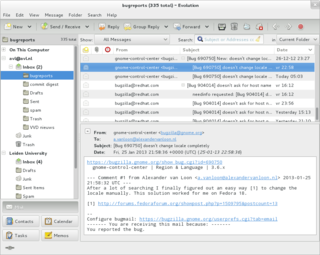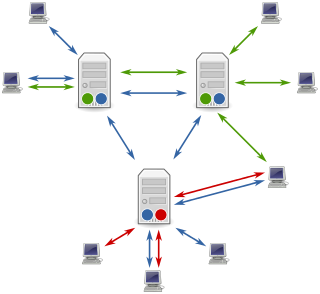Related Research Articles

Electronic mail is a method of exchanging messages ("mail") between people using electronic devices. Email was thus conceived as the electronic (digital) version of, or counterpart to, mail, at a time when "mail" meant only physical mail. Email later became a ubiquitous communication medium, to the point that in current use, an e-mail address is often treated as a basic and necessary part of many processes in business, commerce, government, education, entertainment, and other spheres of daily life in most countries. Email is the medium, and each message sent therewith is called an email.
A Usenet newsgroup is a repository usually within the Usenet system, for messages posted from users in different locations using the Internet. They are discussion groups and are not devoted to publishing news. Newsgroups are technically distinct from, but functionally similar to, discussion forums on the World Wide Web. Newsreader software is used to read the content of newsgroups.
rn is a news client written by Larry Wall and originally released in 1984. It was one of the first newsreaders to take full advantage of character-addressable CRT terminals. Previous newsreaders, such as readnews, were mostly line-oriented and designed for use on the printing terminals which were common on the early Unix minicomputers where the Usenet software and network originated. Later variants of the original rn program included rrn, trn, and strn.

SOAP is a messaging protocol specification for exchanging structured information in the implementation of web services in computer networks. It uses XML Information Set for its message format, and relies on application layer protocols, most often Hypertext Transfer Protocol (HTTP), although some legacy systems communicate over Simple Mail Transfer Protocol (SMTP), for message negotiation and transmission.

Shareaza is a peer-to-peer file sharing client running under Microsoft Windows which supports the gnutella, Gnutella2 (G2), eDonkey, BitTorrent, FTP, HTTP and HTTPS network protocols and handles magnet links, ed2k links, and the now deprecated gnutella and Piolet links. It is available in 30 languages.

A news server is a collection of software used to handle Usenet articles. It may also refer to a computer itself which is primarily or solely used for handling Usenet. Access to Usenet is only available through news server provider.
WebDAV is a set of extensions to the Hypertext Transfer Protocol (HTTP), which allows user agents to collaboratively author contents directly in an HTTP web server by providing facilities for concurrency control and namespace operations, thus allowing Web to be viewed as a writeable, collaborative medium and not just a read-only medium. WebDAV is defined in RFC 4918 by a working group of the Internet Engineering Task Force (IETF).
BitTorrent is a communication protocol for peer-to-peer file sharing (P2P), which enables users to distribute data and electronic files over the Internet in a decentralized manner.
Google Groups is a service from Google that provides discussion groups for people sharing common interests. The Groups service also provides a gateway to Usenet newsgroups via a shared user interface.

A newsreader is an application program that reads articles on Usenet distributed throughout newsgroups. Newsreaders act as clients which connect to a news server, via the Network News Transfer Protocol (NNTP), to download articles and post new articles. In addition to text-based articles, Usenet is also used to distribute binary files, generally in dedicated "binaries" newsgroups.

Newzbin was a British Usenet indexing website, intended to facilitate access to content on Usenet. The site caused controversy over its stance on copyrighted material. Access to the Newzbin.com website was blocked by BT and Sky in late 2011, following legal action in the UK by Hollywood film studios.
NZB is an XML-based file format for retrieving posts from NNTP (Usenet) servers. The format was conceived by the developers of the Newzbin.com Usenet Index. NZB is effective when used with search-capable websites. These websites create NZB files out of what is needed to be downloaded. Using this concept, headers would not be downloaded hence the NZB method is quicker and more bandwidth-efficient than traditional methods.
Protocol encryption (PE), message stream encryption (MSE) or protocol header encrypt (PHE) are related features of some peer-to-peer file-sharing clients, including BitTorrent clients. They attempt to enhance privacy and confidentiality. In addition, they attempt to make traffic harder to identify by third parties including internet service providers (ISPs). However, encryption will not protect one from DMCA notices from sharing not legal content, as one is still uploading material and the monitoring firms can merely connect to the swarm.
Control messages are a special kind of Usenet post that are used to control news servers. They differ from ordinary posts by a header field named Control. The body of the field contains control name and arguments.
The following is a general comparison of BitTorrent clients, which are computer programs designed for peer-to-peer file sharing using the BitTorrent protocol.

Usenet is a worldwide distributed discussion system available on computers. It was developed from the general-purpose Unix-to-Unix Copy (UUCP) dial-up network architecture. Tom Truscott and Jim Ellis conceived the idea in 1979, and it was established in 1980. Users read and post messages to one or more categories, known as newsgroups. Usenet resembles a bulletin board system (BBS) in many respects and is the precursor to Internet forums that became widely used. Discussions are threaded, as with web forums and BBSs, though posts are stored on the server sequentially.
Cross-site request forgery, also known as one-click attack or session riding and abbreviated as CSRF or XSRF, is a type of malicious exploit of a website where unauthorized commands are submitted from a user that the web application trusts. There are many ways in which a malicious website can transmit such commands; specially-crafted image tags, hidden forms, and JavaScript XMLHttpRequests, for example, can all work without the user's interaction or even knowledge. Unlike cross-site scripting (XSS), which exploits the trust a user has for a particular site, CSRF exploits the trust that a site has in a user's browser.
Mail is an email client developed by Microsoft and included in Windows Vista and later versions of Windows. The main function of Mail is sending and receiving email. It is available as the successor to Outlook Express, which was either included with, or released for Internet Explorer 3.0 and later versions of Internet Explorer.
References
- ↑ Reijerman, Dimitri (2010-11-30). "Usenet-tool Spotnet laat gebruikers ook zelf spots aandragen" [Usenet tool Spotnet lets users make spots]. Tweakers.net (in Dutch).
- ↑ Roodbol, Danny (2011-03-15). "Brein: Spotnet geen prioriteit" [Brein: Spotnet not a priority]. Fok.nl (in Dutch).
- ↑ Spotnet
- ↑ Spotweb
- 1 2 Reijerman, Dimitri (2011-03-11). "Populariteit Spotnet groeit snel na sluiting FTD" [Popularity Spotnet grows rapidly after closure FTD]. Tweakers.net (in Dutch).
- ↑ Spotlite
- ↑ Dijkhuizen, Maikel (2011-03-04). "SpotLite 1.0: tweede alternatief voor FTD" [Spotlite 1.0: second alternative for FTD]. Computer!Totaal (in Dutch).
- ↑ μSpotted Archived 2011-03-23 at the Wayback Machine
- ↑ Dijkhuizen, Maikel (2011-07-25). "μSpotted 0.9.18 beta". Computer!Totaal (in Dutch).
- ↑ SpotGrit
- ↑ Dijkhuizen, Maikel (2011-10-12). "SpotGrit (nieuw alternatief voor FTD en Spotnet)" [SpotGrit (new alternative for FTD and Spotnet)]. Computer!Totaal (in Dutch).
- ↑ Django-Spotnet
- ↑ URD
- ↑ BinReader